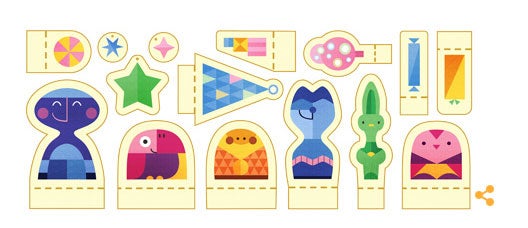Papercraft models and cut outs: Five facts about this year's Happy Holidays Google Doodle
This year's Happy Holidays Google Doodle is clearly intended to send us to the craft table and get making decorations for our homes

Google has rung in the holiday season with a characteristically cheery doodle on its search home page, albeit one in which its letters are more than usually hidden in the imagery. Various animals and one human line up, with sweets, stars and a sideways Christmas tree above them.
That tree is the only nod towards the Christian holiday - previous holiday doodles have featured snowmen, reindeer and festive lights - but the implication is clear. We should get a pair of scissors and start cutting.
The doodle information page tells us that Doodle artist Robinson Wood has created festive characters and items inspired by papercraft models and cut outs. Clicking further takes you to an image search of models to print and cut out - from animals to objects, such as the Tardis and a Dalek from Doctor Who, and even a head of Steve Jobs.
Here are five facts about paper and papercraft.
The art of modelling from paper is called Pepakura
Origami is the most famous form of paper modelling, of course - but must involve a single sheet of paper, which is folded, but not cut. Kirigami by contrast allows some cuts, but still is based on the folding of a single piece of paper. Pepakura is the more developed form.
A cube has eleven nets
One of the simplest paper cutting exercises is building a cube - and the flat layout of a three-dimensional shape is called a 'net'. There are eleven possible nets of a six-sided cube - if you have five minutes spare maybe you could try to work out what they all are.
The record for the largest paper snowflake is 4.4 metres wide
Another favourite paper cut-out shape to try, especially at this time of year, is the snowflake. They're easy enough to make: fold a square of paper diagonally in half, and in half again, then fold this triangle into thirds, cut off the excess, and shape the resulting dart-shaped folded piece of paper at the edges to make its unique design. But the largest paper snowflake, as authenticated by Guinness World Records, was made by Christa Hanson of Kanawha, at the 2012 Kanawha Labor Day Festival. It was 4.4 metres across.
Paper was invented in China in the 2nd Century AD
Prior to the invention of the paper-making process, papyrus, palm leaves, bamboo and silk were used for writing on, but paper, made from wood pulp or rags, was far cheaper and more convenient. The individual generally credited with discovering the process is Cai Lun, a court official from the Han dynasty. He is said to have been inspired by wasps' and bees' nests.
Pollocks Toy Theatres is the last remnant of a thriving paper toy industry
The shop is familiar to anyone who has browsed the Covent Garden market over the last 30 years, and it's this form of paper toy - a theatre to cut out and build, with scenery and characters - that is closest to the 2D characters created by Robinson Wood for his doodle. His designs are simple by contrast. The toy theatre characters still sold by Pollocks - and once priced at "a penny plain and twopence coloured" - are far more intricate. The shop has been on site since 1980, and is the last remnant of an industry that flourished over a hundred years before.
Subscribe to Independent Premium to bookmark this article
Want to bookmark your favourite articles and stories to read or reference later? Start your Independent Premium subscription today.

Join our commenting forum
Join thought-provoking conversations, follow other Independent readers and see their replies